|
Chuuk + Wrecks =
Scuba Divers' Paradise
Photos
and words by John Clayton (unless otherwise noted)
 s
we dropped down to 25,000 feet I saw one of the most extraordinary panoramas
I'd ever been lucky enough to witness. The majesty of it all and the
stunning vistas that lay below and before me were spectacular. It was
as beautiful as spring's first rose, and it made me understand why so
many pilots on commercial jetliners love their job; they get to see
so many awe-inspiring sights from the cockpit. My view was that of a
vast vista of the Pacific. s
we dropped down to 25,000 feet I saw one of the most extraordinary panoramas
I'd ever been lucky enough to witness. The majesty of it all and the
stunning vistas that lay below and before me were spectacular. It was
as beautiful as spring's first rose, and it made me understand why so
many pilots on commercial jetliners love their job; they get to see
so many awe-inspiring sights from the cockpit. My view was that of a
vast vista of the Pacific.
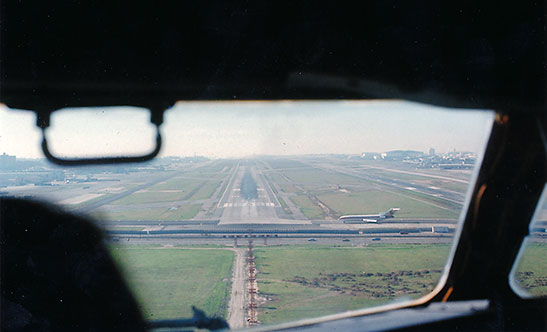
This is not (obviously!) the "awe inspiring"
photo as described by John in his story. It is however, a photo he took
of the view from the cockpit landing at LAX. "It is," he says,
"awe-inspiring to sit up front like this with the pilot, because
it gives one a totally different visual perspective sitting THERE, versus
that of sitting in the passenger part of the aircraft, and looking out
from either the left or right side of the cabin. It's easy to see why
most pilots still love sights like this, even after they've been flying
for years and years." When John took this photo in 1976, he was
Manager of Publicity for Continental Airlines.
I was sitting in the cockpit of a Continental Airlines/Air
Micronesia Boeing 727-100 as we headed towards an island in the Federated
States of Micronesia, located in the western Pacific Ocean, with the
amazing name of TRUK. Now modernized to CHUUK. 2,500 miles from Hawaii,
Truk is one of the four main island groups of the Caroline Islands,
Chuuk, Kosrae, Pohnpei and Yap.
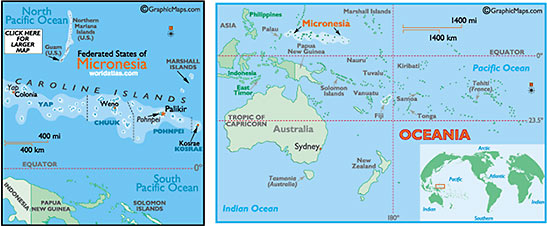
Map of Micronesia as it relates, geographically,
to the Pacific Ocean and Australia (map courtesy Graphic Maps.com) Truk,
now "modernized" to CHUCCK, is to the right of the Yellow
Star
As the editor (in the mid-1970s) of Continental Airlines
monthly employee magazine the Golden Jet, I was on my way to
do a story about "Air Mike's" various island stations in Micronesia,
and the pilot had kindly asked me to "sit up front with him."
"Air Mike" was the name most commonly used by all employees
and many passengers, to describe the pacific operation of this airline.
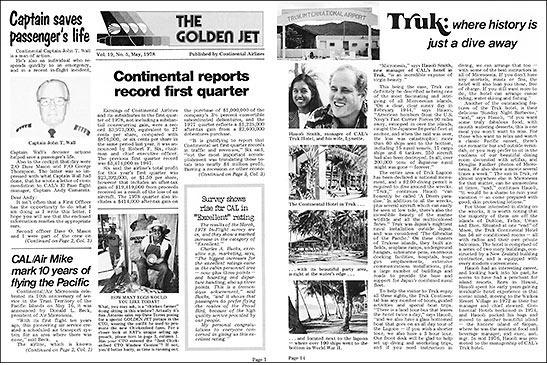
On the left a "sample" of the Continental
Airlines' employee monthly magazine, "The Golden Jet." Note
the story lower left of the page about the 10 year Anniversary of Continental/Air
Micronesia – date of this issue is May, 1978. On the right, John's
feature on Truk. This issue is July 1976.
Even though I know how safe it is to fly, the fact is
that flying over such a vast and seemingly never ending expanse of ocean,
caused me to be, well, "a bit concerned" should anything go
wrong. It didn't, of course, but for those worried about flying YOU
know what I mean.
When Truk came into sight it gave the impression as
being the size of a postage stamp. Then I observed the runway, and it
looked to be the size of a small ironing board. As the Air Mike 727
came lower and lower for our landing, I noted that the runway began
and ended at the ocean, and appeared to be only 100 yards long! I questioned
not only our landing, but if this 70 plus ton jet could stop before
plunging into the ocean at the runway's end. We touched down –
it seemed only inches from the ocean's edge – and a cloud of whitish
dust enveloped our aircraft. I learned later the runway (back then
in 1976) was coral, and coral dust was kicked up by the jet blast.
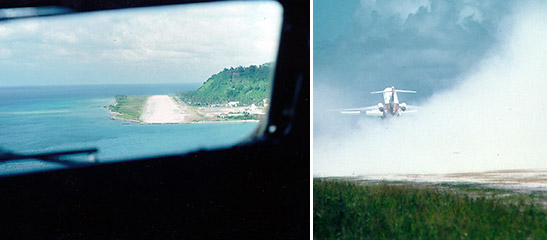
Left: The B-727-100 John was aboard, and sitting
in the cockpit, about to land at Truk. Right: The same aircraft, after
passengers had deplaned and new ones boarded, takes off. Note the coral
dust swirling around BEHIND the jet.
In 1944 Truk was to the Japanese in WW2 what Pearl Harbor
was for the US Navy in 1941. On February 16th-17th, 1944, the US Navy
and aircraft from its carriers, launched a massive, surprise attack
that devastated a huge part of the Japanese fleet based in Truk. What
makes that so fascinating for tourists is that many of the 3 cruisers,
4 destroyers, 32 merchant ships and 270 aircraft still lie in and around
the ocean bottom of Truk and its large lagoon. It is, one mesmerized
tourist said, "a scuba divers' paradise." Because of its historic
significance the entire area has been declared a National Historic Monument,
and if you decide to dive on these wrecks, nothing, absolutely nothing,
must be taken or disturbed.
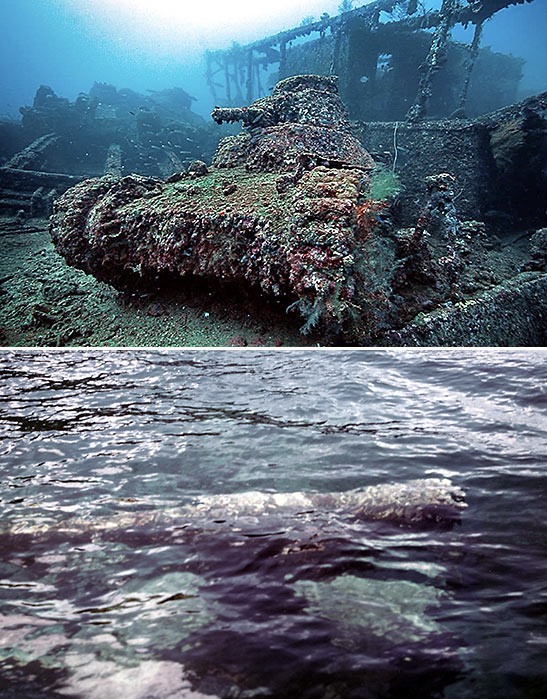
Top: A Japanese tank on the deck of a cargo ship,
both now on the bottom of the Truk Lagoon (photo courtesy Truk Tourism,
1976). Bottom: One of John's photos showing what looks like a large
canon. The interesting thing here is how near to the surface the canon
is. "It is," says John, "absolutely riveting, awesome
and some rather weird way, a bit "spooky" to see these WW2
relics, and knowing the history of the battle in February, 1944, realizing
how close you are to this history." That is why the entire area
was declared a National Historic Monument, and nothing is to be touched
or disturbed.
My 3 day visit to Truk rates as one of the most mesmerizing,
captivating and intriguing travel experiences of my life, during which
my work as a travel journalist and PR executive has taken me to 51 countries
around the world. Confirmation that anything can be achieved in this
breathtakingly wonderful place called America.
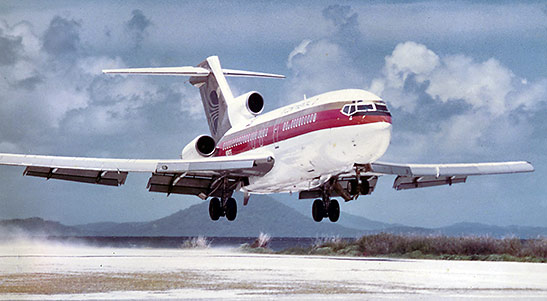
John's "Up close and personal" photo of
the B-727-100 he flew aboard on his trip to Micronesia, a second or
two from landing on Truk's coral runway, May, 1976. This aircraft was
the first B-727-100 to fly the Air Micronesia schedule, and was affectionately
known as "JUJU" by both Air Mike employees and yes, passengers
as well. "If you've ever wondered," says John, "what
happens to commercial aircraft when, like old cars, they are of no use
anymore, the final "destination" of JUJU is both shocking
and yes, sad. But," he says, "that's another story in another
Traveling Boy feature story sometime in the future."
Related Articles:
Aitutaki:
The World's Most Beautiful Island?; Tahiti
and Her Islands; Caramoan,
Philippines: A Survivor's Paradise; The
Romance of Tahiti and Her Islands; To
the Marquesa Islands
|





